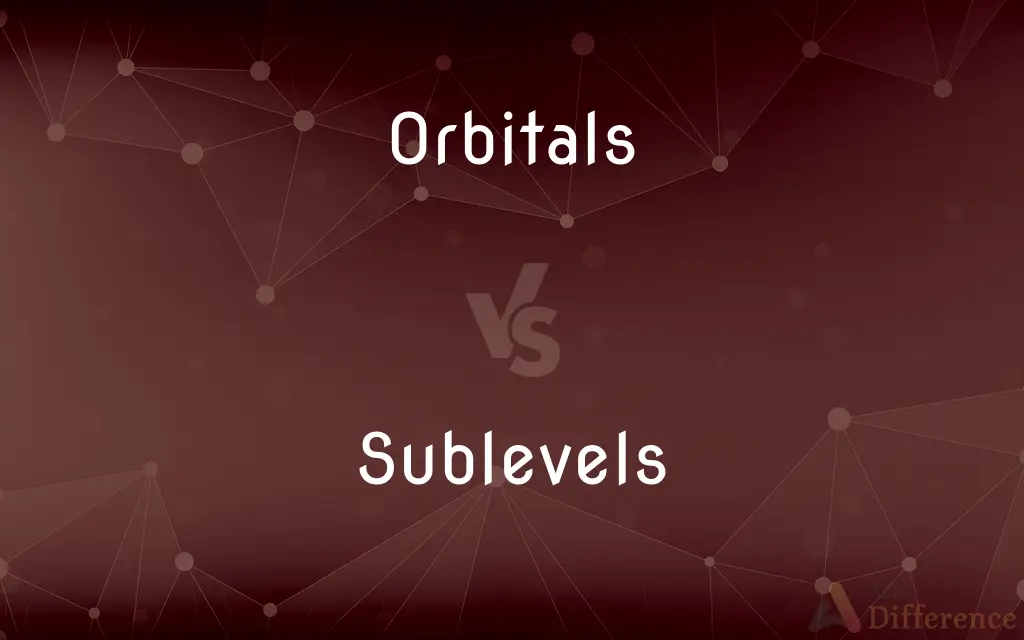Orbitals vs. Sublevels — What's the Difference?
By Urooj Arif & Fiza Rafique — Published on March 5, 2024
Orbitals are regions in an atom where electrons are most likely to be found, each holding up to 2 electrons, while sublevels are divisions within energy levels, categorized into s, p, d, and f types, organizing orbitals of similar energy.

Difference Between Orbitals and Sublevels
Table of Contents
ADVERTISEMENT
Key Differences
Orbitals and sublevels are key concepts in understanding the arrangement of electrons within atoms, crucial for the study of chemistry and physics. Orbitals refer to specific regions around an atom's nucleus where electrons are likely to be located. They are defined by three quantum numbers (principal, azimuthal, and magnetic) and can each hold a maximum of two electrons with opposite spins.
Sublevels, on the other hand, are broader categories within principal energy levels (defined by the principal quantum number) and are identified by the azimuthal (angular momentum) quantum number. These sublevels are designated as s, p, d, or f, each with a different shape and number of orbitals. The s sublevel contains one orbital, p has three, d has five, and f has seven, indicating not just the shape but also the capacity of each sublevel to house electrons.
The relationship between orbitals and sublevels is hierarchical. Sublevels are composed of orbitals, with each sublevel type having a specific number of orbitals. For instance, within a principal energy level, there might be s, p, and d sublevels, containing a total of 9 orbitals (1 in s, 3 in p, and 5 in d), demonstrating how sublevels organize orbitals within an atom.
Understanding both concepts is fundamental to grasp electron configurations and the chemical behavior of atoms. Orbitals directly influence the chemical bonding and properties of elements, as the distribution of electrons across different orbitals and sublevels determines an atom's reactivity, magnetic properties, and more. Similarly, the concept of sublevels helps explain the periodic trends observed in the periodic table, such as ionization energy and atomic size.
Comparison Chart
Definition
Regions where electrons are likely found
Divisions within energy levels
ADVERTISEMENT
Capacity
2 electrons
Varies (2 in s, 6 in p, 10 in d, 14 in f)
Types/Designations
Defined by quantum numbers
S, p, d, f based on shape and complexity
Organization
Individual regions within a sublevel
Organize orbitals within energy levels
Role in Electron Configuration
Specific electron locations
Group orbitals by energy and shape
Compare with Definitions
Orbitals
Specific regions around an atom's nucleus.
Each orbital can hold up to two electrons with opposite spins.
Sublevels
Identified by s, p, d, f designations.
The d sublevel can hold a maximum of 10 electrons across its orbitals.
Orbitals
Defined by three quantum numbers.
The 2p orbital is defined by a principal quantum number of 2.
Sublevels
Influence periodic trends.
The filling order of sublevels explains periodic properties like atomic size.
Orbitals
Directly influences chemical bonding.
Electrons in outer orbitals determine an atom's reactivity.
Sublevels
Categories within principal energy levels.
The n=2 energy level contains s and p sublevels.
Orbitals
Shapes include spherical and dumbbell.
S orbitals are spherical, while p orbitals are dumbbell-shaped.
Sublevels
Organize orbitals of similar energy.
Sublevels group orbitals to simplify understanding electron configurations.
Orbitals
Max capacity of two electrons.
A fully occupied orbital holds two electrons.
Sublevels
Vary in orbital capacity.
The number of orbitals in each sublevel increases from s to f.
Orbitals
Of or relating to an orbit.
Sublevels
Plural of sublevel
Orbitals
The wave function of an electron in an atom or molecule, indicating the electron's probable location.
Orbitals
Plural of orbital
Common Curiosities
Why are there different shapes for orbitals?
The shapes (spherical for s, dumbbell for p, etc.) represent the probability distribution of finding an electron in that space, influenced by the electrons' energy and angular momentum.
How do orbitals and sublevels relate to each other?
Sublevels are made up of orbitals; each type of sublevel (s, p, d, f) contains a specific number of orbitals.
Can two electrons in an orbital have the same spin?
No, according to the Pauli exclusion principle, two electrons in the same orbital must have opposite spins.
What determines the energy of an orbital?
The energy of an orbital is primarily determined by its principal quantum number (n) and, to a lesser extent, its azimuthal quantum number (l).
What role do sublevels play in the periodic table?
Sublevels help explain the arrangement of the periodic table and the periodic trends observed, such as variations in ionization energy, atomic size, and electronegativity.
What is an orbital?
An orbital is a region around the nucleus of an atom where an electron is most likely to be found.
What is the significance of the azimuthal quantum number?
The azimuthal (angular momentum) quantum number determines the shape of orbitals within a sublevel and contributes to the energy level of electrons in those orbitals.
What is a sublevel?
A sublevel is a division within an atom's energy levels, categorized into s, p, d, and f, each containing a certain number of orbitals.
Is the energy of all orbitals within a sublevel the same?
Within a single atom, all orbitals of the same sublevel in an energy level have approximately the same energy, but this can vary due to electron-electron interactions.
Can an electron move between orbitals?
Yes, electrons can move between orbitals, typically through absorption or emission of energy corresponding to the difference in energy levels.
How many electrons can the d sublevel accommodate?
The d sublevel can accommodate up to 10 electrons, as it contains five orbitals, each capable of holding 2 electrons.
How does the concept of orbitals and sublevels apply to molecules?
In molecules, these concepts help explain molecular bonding and the spatial arrangement of electrons, crucial for understanding molecular geometry and chemical reactivity.
How does the electron configuration affect an atom's properties?
The distribution of electrons across different orbitals and sublevels influences an atom's chemical behavior, including reactivity, bonding capabilities, and physical properties.
Why are orbitals important in chemistry?
Orbitals determine how electrons are arranged in atoms and how atoms interact with each other, which is fundamental to understanding chemical reactions and bonds.
What is the maximum number of electrons a single energy level can hold?
The maximum number of electrons in an energy level is given by 2n^2, where n is the principal quantum number of the energy level.
Share Your Discovery

Previous Comparison
Arrest Warrant vs. Bench Warrant
Next Comparison
Insolvency vs. LiquidationAuthor Spotlight
Written by
Urooj ArifUrooj is a skilled content writer at Ask Difference, known for her exceptional ability to simplify complex topics into engaging and informative content. With a passion for research and a flair for clear, concise writing, she consistently delivers articles that resonate with our diverse audience.
Co-written by
Fiza RafiqueFiza Rafique is a skilled content writer at AskDifference.com, where she meticulously refines and enhances written pieces. Drawing from her vast editorial expertise, Fiza ensures clarity, accuracy, and precision in every article. Passionate about language, she continually seeks to elevate the quality of content for readers worldwide.
















































